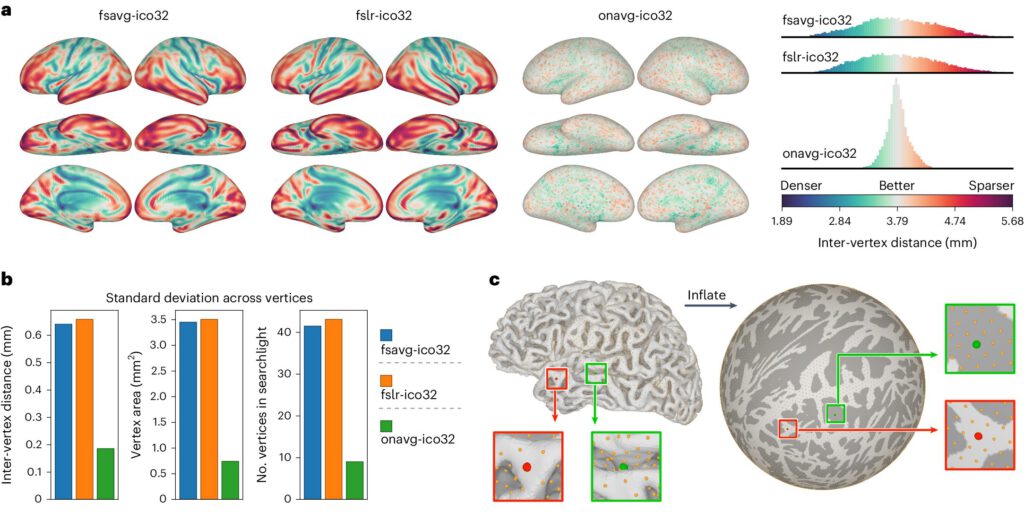Variation of vertex properties across the cortex. a, Vertex distribution for fsavg, fslr, onavg measured by vertex-to-vertex distance. b, Standard deviation of vertex-to-vertex distance, vertex area, and vertex count at 20 mm searchlight for fsavg, fslr, onavg. c, Classical surface templates sample the cortical surface based on a sphere obtained by fully dilating the original anatomical surface. For these templates, the distribution of vertices is nearly uniform on the sphere (right), but far from uniform on the anatomical surface (left) due to geometric distortions introduced by the dilation. Vertices with the same color (red/green, also in zoomed views) are homologous on the two surfaces. Credit: Nature Methods (2024). DOI: 10.1038/s41592-024-02346-y
The human brain is responsible for vital functions such as perception, memory, language, thought, consciousness and emotions.
To understand how the brain works, scientists often use neuroimaging techniques that record brain activity in subjects while they are performing tasks or at rest. Brain functions are systematically organized in the outer layer of the human brain, the cerebral cortex. Researchers often use what are called “cortical surface models” to analyze neuroimaging data and study the functional organization of the human brain.
Every brain is shaped differently. To analyze neuroimaging data from multiple individuals, researchers need to register the data to the same brain template. This allows them to identify the same anatomical locations on different brains, even if the brains are shaped differently. These locations are called “vertices.”
Over the past 25 years, such templates have been refined many times, but the cortical surface template most commonly used today is based on data collected from 40 brains.
Now, Dartmouth researchers have created a new cortical surface template, called “OpenNeuro Average,” or “onavg” for short, that can improve the accuracy and efficiency of analyzing neuroimaging data.
The findings are published in the journal Nature Methods.
“Our cortical surface template, onavg, is the first to uniformly sample different parts of the brain,” says lead author Feilong Ma, a postdoctoral researcher and member of the Haxby lab in Dartmouth’s Department of Psychological and Brain Sciences. “It’s a less biased and more computationally efficient map.”
The team built the template based on the cortical anatomy of 1,031 brains from 30 datasets on OpenNeuro, a free, open-source platform for sharing neuroimaging data. According to the co-authors, this is also the first cortical surface template based on the geometry of the brain.
In contrast, previous templates non-uniformly sampled different parts of the cortex and defined the locations of cortical vertices based on spherical shapes, resulting in biased distribution of vertices.
Using the onavg template reduces the data required for analysis.
“Acquiring data through neuroimaging can be very expensive, and for some clinical populations, such as rare disease studies, it can be difficult or impossible to acquire large amounts of data, so being able to access better results with less data is a major benefit,” says Feiron. “Through more efficient data use, our template has the potential to increase the repeatability and reproducibility of results in academic research.”
“We see ONAVG as a methodological advancement that has broad applications across all aspects of cognitive and clinical neuroscience,” says co-author James Haxby, a professor in Dartmouth’s Department of Psychological and Brain Sciences and former director of the Center for Cognitive Neuroscience.
He says their cortical surface templates could potentially be used to study vision, hearing, language and individual differences, as well as disorders such as autism and neurodegenerative diseases such as Alzheimer’s and Parkinson’s.
“We believe this research will have broad and profound impact on the field,” Haxby says.
Jiahui Guo, a former postdoctoral researcher in psychology and brain sciences and assistant professor in the Department of Behavioral and Brain Sciences at the University of Texas at Dallas, and Maria Ida Gobbini, associate professor in the Department of Medicine and Surgery at the University of Bologna, also contributed to the study.
Further information: Ma Feilong et al., Cortical surface templates for human neuroscience, Nature Methods (2024). DOI: 10.1038/s41592-024-02346-y
Courtesy of Dartmouth College
Citation: New human brain template enhances analysis of neuroimaging data (July 16, 2024) Retrieved July 22, 2024 from https://medicalxpress.com/news/2024-07-template-human-brain-neuroimaging-analysis.html
This document is subject to copyright. It may not be reproduced without written permission, except for fair dealing for the purposes of personal study or research. The content is provided for informational purposes only.

